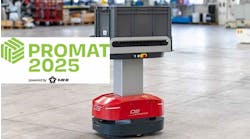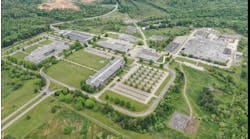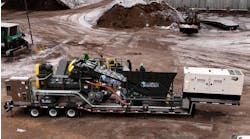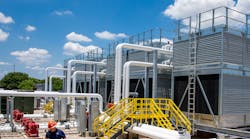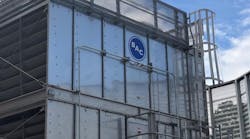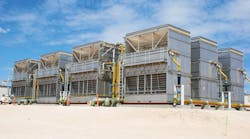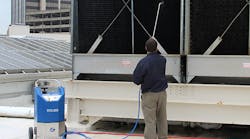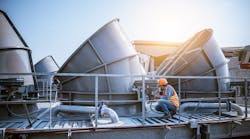Latest from Facility Operations
Understanding Your Different Choices in Fluid Cooling Solutions
Cooling systems for comfort, refrigeration, and industrial applications typically use one of three primary methods for heat rejection: air cooled, water cooled or adiabatic. Hybrid cooling, the rejection of heat using two or more of these methods, has also gained in popularity in recent years.
To choose the optimal cooling system, the engineer must consider the climate, desired operating cost, water availability, cooling load, and any other potential site-specific objectives and constraints such as maintenance.
Air Cooled
Air-cooled systems use dry cooling. Air passes over a finned heat exchanger containing the process fluid. Sensible heat is transferred from the process fluid in the heat exchanger to the airstream flowing through the unit.
To efficiently cool the process fluid to the desired temperature for the system, the dry bulb temperature must be significantly lower than the fluid temperature. In hot climates and during periods of high ambient temperatures, this technology results in higher process fluid design temperatures and lower overall system efficiencies.
Air-cooled units also consume a great deal of energy to operate the fans, which must move a large volume of air. Significantly more heat transfer surface area than the other cooling methods is also required, typically resulting in a much larger footprint for dry coolers than systems that utilize either evaporative or adiabatic heat rejection. The higher system design operating temperature results in significantly greater energy consumption for the system.
Finally, because the system runs with higher process fluid temperatures, and heat is the enemy of mechanical systems, the system lifetime is shorter than alternative cooling systems which offer lower design temperatures.
Water Cooled
Water-cooled systems typically use evaporative heat rejection to maximize energy efficiency and thermal performance. Evaporative cooling efficiently rejects heat from the recirculating water and discharges warm, moist air to the atmosphere by using both the sensible and latent potential of air. Evaporative heat rejection significantly reduces the required fan power, footprint, and, most importantly, the overall system energy consumption. This energy consumption is significantly less than the total energy usage of similarly sized systems using either air-cooled or adiabatic heat rejection.
In cooling towers, fluid coolers, and evaporative condensers, a spray system passes water over fill media and/or a heat exchanger. Using the same physics as perspiration, the evaporative process cools the surface of the water as the H2O molecules transition from the liquid to the gas phase. Heat is then rejected to the airstream through the unit and ultimately into the atmosphere through the evaporative cooling process.
The evaporative process is dependent on the ability of the entering air to absorb the evaporated water molecules using the enthalpy driving force of the air. The drier and less humid the air, the higher this potential, as indicated by the wet bulb temperature, which is always equal to or less than the dry bulb temperature of the air. The wet bulb temperature is related to the amount of moisture in the air relative to the dry bulb temperature. An evaporative cooling tower can lower the process fluid in the heat exchanger to within a few degrees of the wet bulb temperature.
Evaporative cooling towers and fluid coolers have proven to be powerful, energy-efficient cooling solutions in all climates. While they do use water, which is typically far less expensive than energy, it's still an important natural resource to conserve. This conservation is accomplished by developing and implementing an effective water treatment program for the site.
Adiabatic Cooling
Adiabatic cooling systems also use evaporation, but as a means of cooling the entering air passing through a finned heat exchanger. In a properly designed and operated system, the finned heat exchanger stays dry, protecting the surfaces from scale and corrosion. The adiabatic air cooling can be accomplished by spraying water into the airstream or by using wetted pads that provide a surface for water and air to interface.
In the first case, the goal is that the water sprayed into the airstream evaporates before reaching the finned coil, avoiding scaling and corrosion on the coil which can negatively impact system efficiency and equipment lifetime. In the second case, a wetted pad is used to cool the entering airstream. The pads are specially designed to retain water on the surface of the pads to ensure that it does not carry over to the finned coil, minimizing the risk of coil damage.
The use of a small amount of water to precool the air entering the heat exchanger lowers the required airflow and fan power compared to air-cooled units, while also lowering the fluid temperature back to the system. In the most efficient adiabatic systems, the air is cooled close to the wet-bulb temperature. Such substantial depression of the air temperature results in a significant increase in dry cooling capacity and energy efficiency compared to dry-only designs. Once the ambient temperature begins to approach freezing, or during times of reduced load, the unit can be switched to operate in a dry-only mode, thus decreasing water usage.
Adiabatic heat rejection system controls are designed to be flexible, intelligent, and customer-friendly, taking full advantage of the dual operating modes. At a customer-selected design point, such as a cooler ambient dry bulb and a lower heat load, the unit can turn off the recirculating water and switch to operation in dry mode. Additionally, the low volume recirculating water sump automatically drains when freezing temperatures are experienced, negating the need for sump heaters.
The recirculating design of an adiabatic heat rejection system consumes less water than an evaporative cooling tower. Note that some designs use a “once through” wetting system which can substantially increase water usage, as compared to the recirculating type system. However, such designs may also violate local codes banning the use of once-through cooling so local code officials should be consulted.
Hybrid Cooling
Hybrid cooling products use a combination of dry and evaporative heat rejection technology. Combining the benefits of both, hybrid products can be ideal for water-sensitive applications while still offering high energy efficiency. They have the option to operate “wet”, adding the benefits associated with either evaporative or adiabatic heat rejection, as well as operate in a dry mode. Depending on the customer’s water and energy requirements, along with ambient conditions, these products can shift the load to the proper method of heat rejection to optimize the conservation of both water and energy for a specific site.


